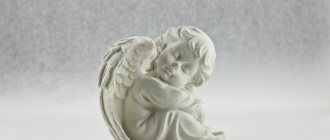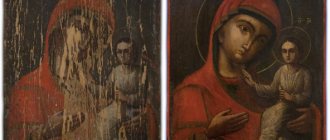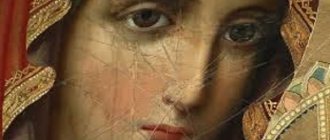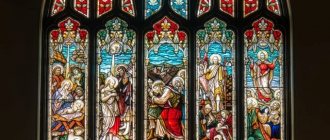Sacred images are endowed with particularly strong energy and accompany people for many centuries, therefore, in the minds of our ancestors, religious beliefs were closely intertwined with beliefs and mysticism. The clergy classify any signs associated with icons as superstitions that are unacceptable for a believer. However, you need to know how to handle the faces of saints in order to protect yourself from harm.
Signs associated with icons
There are a large number of folk beliefs regarding sacred images. Some of the most popular signs associated with icons include the following:
- falling image - to problems and troubles;
- an image shattered into pieces - the incident promises troubles and misfortunes;
- finding the face of a saint lying on the floor is a sign that you need to pay attention to your health;
- catching a falling icon means good news and positive changes.
You should not swear or use foul language when near holy images, as this is a bad omen, foreshadowing illness and shortened life expectancy.
Is it possible to purchase from hand?
Superstitious people try to buy only new images. After all, sacred images are distinguished by their ability to accumulate both positive and negative energy, and therefore there is a risk of receiving negativity along with the icon, passed on from the previous owner.
It is believed that sacred things are used not only for prayer and reflection on faith. Some magicians use icons to cause damage, transfer their problems or illnesses to another person. You should not purchase this item secondhand or at a pawnshop, since it is impossible to find out the history of either the past owner or the image itself.
The priests do not see anything reprehensible in such a purchase. It is believed that no negativity, including that directed from the outside, can “stick” to the symbol of faith. One of the main church rules is that you cannot pray to an unconsecrated icon. Therefore, hand-bought images of saints must be taken to the temple and consecrated. After the priest reads a special prayer, you can take the icon home.
Is it possible to take other people's icons?
The Church claims that the image of saints is not a personal amulet at all, but a symbol of faith. It does not matter who previously owned the icon and how it came to be from the previous owners. The main thing is that it be consecrated in the church. But both esotericists and clergy note that the strongest positive energy comes from an image donated by close relatives during an illness or during a difficult period in life.
Those who are worried about the accumulated negativity should not accept or buy someone else’s icon as a gift. Thoughts about bad omens will not allow you to concentrate on prayer. Everyone else must definitely consecrate the image in the church, because this way you can cleanse the image of the negative energy present in it. If the icon causes discomfort and anxiety, it is better to get rid of it, but not throw it away, but leave it in the church.
Why does a candle light up?
Most often, such incidents indicate non-compliance with fire safety rules.
If the icon caught fire from a candle or lamp, this may also indicate negativity accumulated in the room.
Such signs are a warning about future problems, misfortunes, troubles, which can be avoided by being attentive and careful.
Why does he disappear from home according to signs?
It may seem that a missing icon is a bad sign that does not bode well for its owners. However, esotericists and bioenergetics adhere to a different point of view. In their opinion, if the image disappeared, it means that it did everything possible for its owner and was filled with negative energy.
In this case, you need to go to the temple and purchase a new icon, consecrate it and bring it home, instead of the disappeared one.
The Russian Orthodox Church called any transactions with icons illegal and unacceptable
Recently, information has been increasingly received that in both the Old Believer and New Believer churches there are people who collect ancient icons and church utensils from churches and monasteries, who offer the abbots, who are not able to restore them, to give them these icons, and in return paint a new icon or make monetary compensation, taking into account the material needs of many churches. According to the legislation of the Russian Federation, such an action is a crime , and according to the rules of the Church, it is a violation of the patristic canons .
In Circular of the Russian Orthodox Church No. 991 dated February 24, 2016, Metropolitan Juvenaly of Krutitsky and Kolomna reports:
I remind you that the preservation and transmission to future generations of the priceless spiritual heritage of the Russian Orthodox Church, captured in monuments of church art - architecture, icon painting, works of fine and jewelry art, sculpture, has always been an obvious and urgent task of the Church.
The sacred canons, in particular, canon 12 of the VII Ecumenical Council , establish the principle of the inviolability of church property. This principle is expressed in categorical form in Rule 35 of the Council of Carthage :
It is required that no one sell church property.
If there is a need to transfer church property, then, according to 38 and 41 of the Apostolic Canons , 35 and 42 of the Council of Carthage , its manager is the ruling bishop or council of bishops. In particular, Rule 42 of the Council of Carthage states:
It is also determined that presbyters, without the permission of their bishops, should not sell things to the Church to which they are ordained.
Further, Metropolitan Yuvenaly continues his appeal to the dean of the Moscow diocese:
According to modern church legislation, ancient icons, as well as items of church utensils related to museum objects and collections, as well as those created before 1940, are classified as especially valuable movable property of religious organizations of the Russian Orthodox Church (Regulations on the uniform procedure for the ownership, use and disposal of real estate and especially valuable movable property of religious organizations of the Russian Orthodox Church, approved by the Holy Synod of the Russian Orthodox Church on July 27, 2011 (magazine No. 77)).
According to clause 4.2. of this Regulation, parishes, brotherhoods (sisterhoods), diocesan monasteries, bishops' metochions, religious educational institutions of diocesan subordination do not have the right to enter into transactions for the disposal of especially valuable movable property for liturgical purposes (including contracts of sale, lease, pledge of this property). The regulation allows for the transfer of especially valuable movable property for liturgical purposes to the ownership (use) of the diocese, the structure of which includes these religious organizations. Moreover, such transactions are carried out on the basis of the order of the diocesan bishop.
Thus, the Russian Orthodox Church has determined that transactions for the alienation of ancient icons and objects of church utensils (direct sale of them to buyers; transfer of several icons or objects for restoration under the condition that part of them become the property of the restorers; exchange of ancient icons or objects for new ones, etc.) d.) are illegal and unacceptable , and clerics guilty of concluding these transactions are subject to canonical measures and criminal liability . Meanwhile, the Old Believer world is increasingly shaken by news about yet another illegal sale of church icons, the replacement of old icons with new ones, the transfer of icons to non-believers for restoration, and other illegal actions. At the moment, in the Old Believers there is not a single Resolution of the Council or other document defining the measures of canonical influence in such a situation.
How to get rid of an icon
Holy faces require respect and reverence. However, there are times when it is necessary to get rid of icons, for example, due to their disrepair or the death of the former owner. Sometimes esotericists advise removing images from the house that have seen a lot of troubles, negativity, and illnesses in their lifetime, since they are overflowing with negative energy and can attract it to their owners.
Whatever the reasons that prompted you to get rid of the icon, it is strictly forbidden to throw it away like ordinary garbage, so as not to bring misfortune on yourself and the whole family.
Belonged to strangers
Despite the fact that the church allows holy images left over from previous owners to be kept in the house, many people prefer to get rid of them. The fact is that icons have the ability to absorb the energy of a person who prays on them. Without knowing the history of the image, you can incur someone else's negativity.
Throwing away church paraphernalia is strictly prohibited - it is considered a great sin. You can solve the problem by taking the image to the temple and leaving it near the altar or donating it to the church.
Remaining from a deceased person
If the previous owner has passed away, then relatives often do not know what to do with the icons correctly. If the deceased was a kind and God-fearing person, then the images that belonged to him can be left behind. It is very likely that they will become a real talisman and amulet for the home.
It is recommended to take the inherited symbol of faith to the temple so that the priest will read a special cleansing prayer and consecrate it, if necessary.
As a last resort, icons of a deceased person can be donated to the church or given to friends.
The most important rule is to never treat sacred images like unnecessary trash. It is strictly forbidden to tear, break, or deform images.
Such a sin may result in severe punishment, including death.
Inherited from the former owners of the house
Sometimes, when purchasing living space, new owners discover images left by the former owners. The priests claim that you can keep such icons for yourself - nothing bad will happen.
If you doubt the history of the image, you can take it to church and re-consecrate it. An icon is a shrine and should be treated accordingly. Therefore, if you do not want to leave sacred images at home, the best solution would be to give them or donate them to the temple.
Dilapidated
Old icons must be taken to the temple. If the image has completely lost its appearance, it will be burned in the church stove. If the icon is only slightly damaged or its colors have faded, then it is likely that one of the poor parishioners will happily take it.
This way one expresses love and respect for deceased relatives.
Another option is to hand over an old icon that needs restoration to a church shop.
Is it possible to burn
Old icons that have completely lost their appearance are allowed to be burned. It is better to entrust this procedure to the clergy, giving them the image. It is allowed to burn the attribute of faith yourself, following certain rules:
- The ceremony should be performed during daylight hours, choosing any day except Sunday.
- Icons are burned separately, in a clean and tidy place, and not in a heap with garbage.
- It is recommended to collect the ashes and bury them in the ground, after reading a prayer before doing this.
An icon is an attribute and symbol of faith. Careful and respectful attitude towards sacred images, regardless of their history and condition, will protect you from numerous troubles and attract goodness and good luck into your life.
Is it from demons to change your appearance, including with makeup?
Estimated reading time: 2 minutes.
Reader question:
Hello father! Please help me understand the discussion with my husband. The Lord created man in his own image and likeness. Is it from demons for a person to change their appearance, including with the help of makeup? My husband forbids me to wear light makeup, do manicures, or paint my nails.
Olga
Archpriest Rustik Vyazovsky answers:
Archpriest Rustic VYAZOVSKY
Hello Olga!
The image of God is not a matter of appearance. This is a set of traits in which a person is similar to the Lord - reason, literature, free will, the gift of creativity, conscience. The likeness of God is holiness. This does not apply to the issue of appearance or gender (see Makeup - a distortion of the image of God?).
The answer to your question is in motivation, in the purpose for which you want to decorate yourself. The external attractiveness of the spouses is a gift that they dedicate to each other. The wife is expected to decorate her body according to her husband's preferences. Your beauty belongs to him, just as his attractive features belong to you. The Apostle Paul teaches: “The wife has no authority over her own body, but the husband does; Likewise, the husband has no power over his own body, but the wife does” (1 Cor. 7:3). That is why you wear your husband’s wedding ring, and he wears yours. Why, or for whom, do you want to apply makeup or manicure? Your spouse is against it. A completely logical question arises: Do you want to please other men, or become the envy of women? Even if you want to do this “for yourself”, based on your own aesthetic preferences, peace in the family is more valuable. As the song says, “The most important thing is the weather in the house, and everything else is vanity. There’s me and you, and everything other than that can be easily fixed with an umbrella.” Only both of you, in mutual agreement(!), can establish the rules and traditions of living together. In marriage, everything should be subordinated to the main thing - cultivating love between you. Are manicures and makeup worth sacrificing for the sake of the most important thing - peace and good relationships with the person closest to you? Moreover, the main adornment of a person is something completely different: “Let your adornment not be the outward appearance of braided hair, or gold ornaments, or finery in clothing, but the innermost person of the heart, in the imperishable beauty of a meek and quiet spirit, which is of great price in the sight of God” (1 Pet. 3.3-4).
Decorating yourself is not a sin, but it is a sin to do it to the detriment of your marriage, and therefore your soul. I believe that you will choose not to decorate your skin or nails, but to preserve the most valuable thing - the beauty of your relationship with your spouse...









